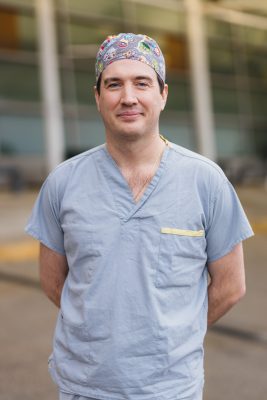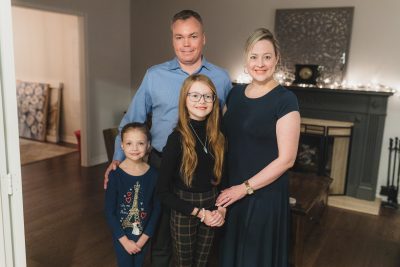
Finding answers to a child’s medical mystery
When Oakville mom Leigh Anderson asked doctor after doctor about small, mysterious bumps cropping up on her toddler’s tongue, and questioned why the tongue sometimes turned a vibrant shade of purple, the response was always the same.
“They were stumped,” says Leigh, whose daughter Maggie is now 10 years old. “From our family doctor to emergency department doctors, to ears, nose and throat specialists, no one knew what was causing these symptoms.”
“We searched for almost four years before finding answers.” — Leigh Anderson, mom
The bumps and discoloration came and went, becoming more severe as Maggie got older. One time, she woke up with a very swollen tongue and was hospitalized. “It was really scary,” recalls Leigh, who spent close to four years chasing down answers to these baffling symptoms. “I documented everything in a binder, taking it from doctor to doctor in hopes of getting a diagnosis.”

Maggie (right) developed a grapefruit-sized lump on her neck that turned out to be a treatable birthmark. She’s pictured here with her younger sister, and fellow Disney princess, Maddie.
Medical tests done along the way ruled out anything serious. “Maggie was perfectly healthy in spite of these symptoms,” says Leigh. Then when Maggie was six years old, she developed a large growth that protruded from the side of her neck. “It looked like she was cradling a grapefruit under her chin,” says Leigh. “It was huge, and undeniable.”
Tongue and neck issues were birthmarks
An ears, nose and throat specialist referred Maggie to a surgeon at Hamilton Health Sciences’ McMaster Children’s Hospital (MCH), who immediately recognized the sac at her neck as a type of birthmark called a lymphatic malformation.
Birthmarks, called vascular anomalies in the medical field, are growths made up of blood vessels that have developed incorrectly. These growths may be solid or made up of arteries, veins, capillaries, lymph vessels, or any combination of these.
The kind of birthmark Maggie has is treated using interventional radiology rather than surgery, so the surgeon referred Maggie to his colleague Dr. John Donnellan, a pediatric interventional radiologist at MCH’s Pediatric Vascular Anomalies Clinic.
“I often hear from families that have spent years seeing other doctors, and trying to get a diagnosis.” — Dr. John Donnellan, HHS pediatric interventional radiologist
The clinic specializes in treating kids who have issues with their blood vessels or lymph vessels, including many types of birthmarks.
Better than surgery
Donnellan is the head of pediatric imaging and pediatric interventional radiology at MCH, and site chief at MCH. He treats lymphatic malformation birthmarks using an outpatient procedure called sclerotherapy, which is best known for treating varicose and spider veins.
The mark is now so tiny, it’s not noticeable

Dr. John Donnellan
With this treatment, a needle is used to remove the fluid from the sac, and then a solution is injected into the sac that causes its lining to stick together so the sac can no longer fill with fluid. Interventional radiologists use ultrasounds, x-rays and sometimes CT scans to guide this minimally-invasive procedure, which is done as a day surgery.
Maggie needed two treatments which both took place in 2019. The mark is now so tiny, it’s not noticeable. Because it’s a birthmark, it can’t be removed completely, says Donnellan, but with treatment it can be shrunk to a size that’s barely visible. Maggie can also visit the clinic as needed, for quick intervention in case she develops other bumps that don’t clear up on their own.
A different kind of birthmark
One in 10 children has a vascular anomaly, more commonly known as a birthmark. In almost all cases, these children were born with their birthmarks, but they can become more obvious as they age.
Vascular anomalies are divided into two categories – tumors and malformations. Tumors are best known as stains on the skin that often fade with time and can be monitored by a family doctor.
Malformations have three main types – lymphatic, venous and arterial – and are best treated using interventional radiology.
- Lymphatic: With this malformation, like Maggie had, a sac of skin fills with lymph fluid. This occurs when lymph vessels form abnormally, and are most common on the head and neck. They’re not usually life threatening, but they can be uncomfortable and very large, limiting movement. In Maggie’s case, small bumps would come and go, as her body reabsorbed the lymphatic fluid, and would sometimes cause tongue discoloration. But in the case of the grapefruit-sized malformation, fluid continued to build.
- Venous: This type of birthmark happens when veins don’t form normally, and are noticeable because the abnormal clump of veins either creates a discoloration to the skin or a bump that comes and goes. They can be painful, and treatment focusses on pain relief.
- Arterial: These malformations are the most difficult treat. They happen when an abnormal tangle of blood vessels, commonly connecting arteries and veins, disrupts blood flow and oxygen circulation. These malformations typically lead to amputation. Treatment aims to postpone amputation for as long as possible.
Spreading the word
The Anderson family is sharing Maggie’s story to help get the word out about these lesser known birthmarks, and MCH’s Pediatric Vascular Anomalies Clinic, so other families don’t have to struggle the way they did to find help.
Maggie’s treatment has been life-changing

The Anderson family is helping to spread the news about the Pediatric Vascular Anomalies Clinic at McMaster Children’s Hospital.
“We searched for almost four years before finding answers,” says Leigh, who had never heard of lymphatic malformations until being referred to MCH.
Leigh’s not alone. Even in the medical community, unusual growths aren’t always recognized as birthmarks.
“I often hear from families that have spent years seeing other doctors, and trying to get a diagnosis,” says Donnellan. “If they are eventually referred to our clinic, we can often make a huge difference with a just couple of treatments.”
Maggie’s treatment has been life-changing, says Leigh, whose daughter’s positive self-image extends to the stage where she dances ballet, modern, hip hop and tap. “Now she can focus on just being a child.”
The MCH experience has also given Maggie some inspiration for what her future might hold.
“She loves Dr. Donnellan, and talks about how she might like to be an interventional radiologist someday,” says Leigh. “That’s about the best review a child can give a doctor. She wants to be just like him when she grows up.”

